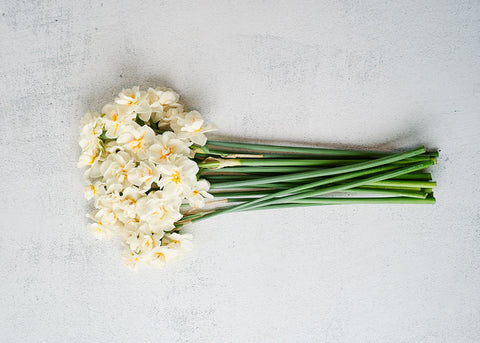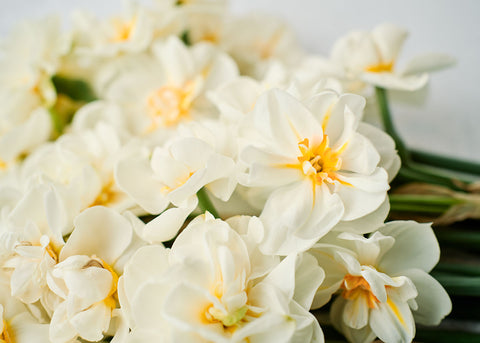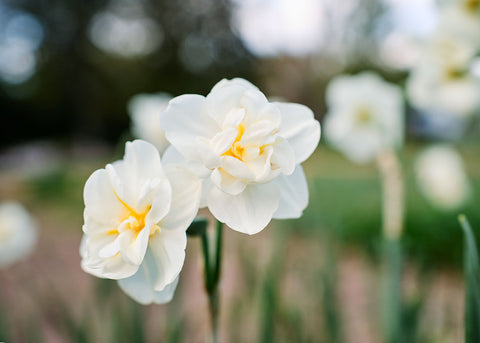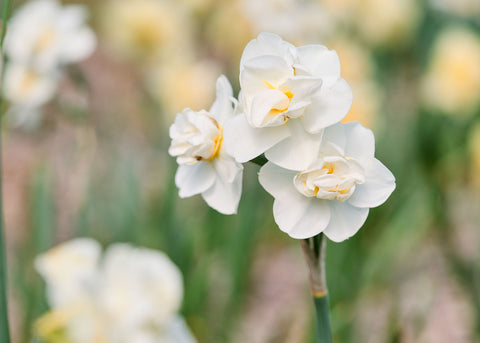











Cheerfulness - Narcissus Bulbs
🚚 FREE SHIPPING for all orders over $79!
Prepare the planting site:
With few exceptions, all daffodil bulbs require the same sort of planting site: well-draining, neutral ph soil that is free of disease with at least six hours of daily sunlight. Avoid planting them near roadways or driveways where plowed snow may contain harmful de-icing compounds. Keep daffodil bulbs away from aggressive tree and perennial plant root systems that can strangle bulb roots and compete for water and nutrients. Ensure proper water drainage to avoid excessive moisture and standing water that can cause bulb rot.
Never use acidic or alkaline soil amendments:
Avoid using acidic or alkaline soil amendments such as mint compost, horse manure, chicken droppings, mushroom compost, or other "hot" manure, garden compost, household compost, or commercial soil amendments for daffodil planting. These amendments can create imbalanced ph levels that hinder root growth and may rot the bulbs. Garden and household composts that haven't decomposed fully can also harbor damaging fungus and weeds.
Planting: depth, spacing, which-end-is-up:
Dig holes to the proper depth and spacing as instructed for each daffodil bulb. It's recommended to dig 2 to 3 inches below the planting depth to loosen the soil for better root growth. Most daffodil bulbs should be planted 6 to 8 inches deep and 6 inches apart to avoid root entanglement. Plant each bulb with the pointed end facing up and the basal plate (root base) down. Cover the top of each bulb with 3 to 4 inches of soil, being careful not to break any sprout growth. Never add anything to the bottom of the planting hole to avoid root burn.
Fertilizing daffodil bulbs:
Daffodil bulbs come with the nutrients they need for spring blooms. However, you can start fertilizing them three times a year after planting. Top-dress the daffodil plantings with a 4-10-6 organic granular fertilizer in the fall to promote root growth, in the spring when the sprouts emerge to support foliage and flower growth, and when the flowers start to die back to nourish the bulbs. Broadcast the fertilizer at a rate of about one teaspoon per bulb. Water lightly after fertilizing if there is a prolonged dry period.
Fall mulching:
Apply a maximum of a 2-inch layer of mulch only after the ground surface freezes in the fall. The mulch helps trap cold in the soil, retain moderate soil moisture, and protect the bulbs from temperature fluctuations. Suitable mulching materials include straw, salt marsh hay, or oak leaves. Remove or loosen the mulch before the sprouts emerge in spring.
Avoid planting in exterior containers or raised beds:
Daffodil bulbs should not be planted in outdoor containers, window boxes, or raised beds that experience temperature fluctuations and repeated freezing and thawing. These conditions can damage the root growth, result in frozen or rotted bulbs, and prevent foliage and flower production. Daffodil bulbs need consistent cold winter temperatures with good water drainage to develop a mature root system for spring growth.
Bloom times, size, and color:
Bloom times, heights, and colors of daffodils are affected by temperature, sunlight, and site conditions, regardless of the calendar date. Warmer climates result in earlier blooms, while colder climates have later blooms. Factors like temperature spikes and site conditions can also impact flower form and color maturation. Each spring may bring surprises in the garden due to varying conditions.
Spring enjoyment and care:
Before daffodil sprouts emerge, remove or loosen any mulch and apply a light top dressing of a granular, organic 4-10-6 fertilizer on top of the soil. This helps promote foliage and flower growth. Enjoy the daffodil blooms in spring and, when the flowers start to die back, apply another light top dressing of the same fertilizer to nourish the bulbs. After the foliage has yellowed or browned, it is dead and can be raked up and discarded. Leave the bulbs in the ground to regenerate.
Plant a separate cutting garden:
If you plan to cut daffodils for bouquets, create a separate cutting garden rather than cutting from your display beds. Cutting daffodil stems can affect the bulb's vitality for future blooms. Cut daffodil stems should not be mixed with other cut flowers due to the viscous substance they release, which can clog other stems. Enjoy individual daffodil stems in bud vases or create arrangements with different varieties in separate vases.
NON-GMO
Open-pollinated seeds perfect for seed saving
HIGH QUALITY
Third-party lab tested to ensure strong germination and seed vitality
100% SATISFACTION
We'll make it right if there's a problem
HAND PACKED
Created with love in Pottstown, PA
ORGANIC SEED
140+ Organic and Certified Naturally Grown varieties available
FREE SHIPPING
Fast & free shipping on orders $79+
